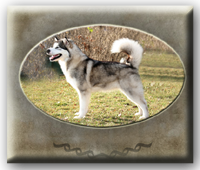Popular Sire syndrome and concerns of genetic diversity
By Cesare Giammiro (Bear-Pak Malamutes)
There are sure very different ideas regarding breeding plans and methods, especially regarding tight breedings as opposed to plans based on low inbreeding coefficients.
In Europe (and especially in northern countries from what I know) the tendency is to breed with low COI's, the reason being the concern regarding health that is somehow supposed to be at risk with tighter breedings.
Altough this may be true to an extent I think this has probably more to do with problems related to certain lines and specimens than to the way they are bred.
Breeding two unhealthy dogs will only produce more of the same, and therefore, if a problem is hidden linebreeding will make it evident.
But this has nothing to do with linebreeding in itself; we may say that linebreeding may bring to the surface pre-existing problems rather than creating new ones.
It is a matter of trying to understand wether one prefers not to run the risk to incurr in a problem or if one prefers to know what problems are hidden behind an apparent healthy line and trying to solve them if and when unfortunately they may show up.
One thing is for sure, a healthy linebred dog offers much better guarantees to be from genetical defects than one coming from generations of outcrosses, and this is particularly true about simple recessive traits.
It is not my intention to convince anyone to change their mind or even less to judge anybody or any breeding plan of course, but while I must admit that some breeders are obtaining good results with plans based on low inbreeding coefficients, I also wish to make it clear that the tight breeding approach to purebred breeding still makes a lot of sense, at least so long as it is backed up by a good knowledge of the potential risks and defects that a given line may carry.
Despite this facts, the latest "fashion" and the most fierce (and less moderate) opponents of linebreeding/inbreeding are considering this as a disreputable practice that serious breeders should not even contemplate, if not for other reasons for the safeguard of the "genetic diversity" of the breed.
While it is not the goal of this article to discuss the issues related to heterozygosity, homozygosity etc.. (and the risks of extreme positions that in some cases are threatening to ban the breeding of purebred dogs...), I think it is important to bring to the attention of dog breeders the results of a recent study that explains how and why linebreeding is probably the best way to preserve the "genetic diversity" that we all care for and that of course is so important for the future of the breed.
The results of this study was summarized in a presentation that was feautured in the February issue of the 2004 AKC Gazette page 73, by Lynne Kuczynski Veasie, about the 2003 Canine Health Conference , entitled "Popular Sire Syndrome and concerns of genetic diversity" (see below):
2003 AKC canine health conference
Popular Sire syndrome and concerns of genetic diversity."Breeders underestimate the amount of diversity that can be present in a breed, even one with a limited group of founders.
A molecular genetic study of the Chinook dog, which was reduced to four individuals in the 1970s, showed there was significant gene diversity and heterozygosity in the breed.
The perceived problem of a limited gene pool has caused some breeders to discourage linebreeding and to promote outbreeding in an attempt to protect genetic diversity. However, this is based on a fallacy.
Studies in genetic conservation and rare breeds have shown that this practice actually contributes to the loss of genetic diversity: by uniformly crossing all "lines," or families of dogs in a breed, you eliminate the differences between them, and therefore lessen the diversity between individuals.
The process of maintaining seperate lines, with many breeders crossing between lines and breeding back as they see fit, maintains diversity in the gene pool."
written by Lynne Kuczynski Veasie, guest columnist of Skye Terrier Feb
Column in AKC Gazette 2004. P. 73
What some breeders don't seem to realize is that despite the relatively small number of foundation dogs upon which our breed was based, we are used to working with lower COI's than most other breeds, and personally I don't see why we should worry and try to make them even lower.
So I think that basically it is not a matter of "breeding wide" to avoid problems; it is first of all a matter of preventing affected dogs or carriers from being bred, and second it is a matter of preventing the same genes to be widespread over a large population, which happens basically when all are breeding from the same stud (popular sire syndrome), and because of mindless outcrossing.
This is a situation that we should know quite well in Europe, and this is proved by the fact that it is very difficult to find here pedigrees that don't contain the same lines which I won't mention but that we all know to be very popular in our continent.
I think this is the true enemy of the future of the breed.
As to the reputability of breeders according to their breeding plan, I do not think this is inversely proportional to COI's as some suggest; the lower the COI the more reputable the breeder.....
To me the reputable breeder is the one:
- who always screens breeding prospects for hereditary diseases. And about this point let's all remember that so called "doubles" are the safest screening method for simple recessive defects;
- who works within his/her own line with occasional outcrosses;
- who doesn't run after the top winning stud of the moment, unless genetically compliant to his/her line and carries no hereditary defects.
- who doesn't "pollute" a large part of the population with his/her own gene pool. This is achieved not only through production of a few litters, but also through refusal of stud service to unsuitable and unrelated lines.
Maybe my thoughts are emphasized by the difficulty which I encounter in working with a line (T'domar Kodara) which is not well represented in Europe, but I think the biggest problem will come the day we all will have no more lines to outcross to, and this is one of the reasons why I think we all should try to work on our gene pool in order to create well defined "blood lines", so that it is still possible to "outcross" to other linebred specimens of similar "blood stream" (going back to same ancestors and of same type) favouring "hybrid vigour" and genetic recombination while maintaining a genotypical diversity with other lines and lowering at the same time the risk to "import" undesired phenotypical traits.
After saying all this, I must say that of course I agree that breeding too tight for several generations may cause problems, although this probably depends a lot on the lines involved in the program and on experience and knowledge of the breeder, as some lines that were linebreed with high COI's (10% to 20%) for many generations are not showing yet any sign of genetic depression.
P.S.
Preserving the variety of malamute’s lines
The variety in phenotype is typical of the Alaskan Malamute breed and it's a heritage of the process that led to today's Alaskan malamute. So in my opinion it is a good thing that animals of different type can still be considered as Malamutes, just think at the differences between the M'loots, the Kotzebues and to some extent to the third strain dogs that Robert Zoller used. So it is important that these differences can still be found in today's breeding stock, and this is where the real "genetic diversity" of our breed lies, and where it has to be preserved. Different strains have to remain separate.
However, based on our experience and on that of those who have bred same lines as we do, I can tell you that the stock we breed yields the best result when it is crossed to animals with same or similar background.
One does not necessarily have to breed open pedigrees or totally different lines to lower the inbreeding coefficient on one's breedings. On the opposite breeding within lines who carry similar phenotype and share a similar genetic pool in the background usually produces better results in terms of "type retention" while still allowing to breed not too close, if that is one's approach or desire. I know some kennel clubs don't allow breeding tight so for some breeder's this may be the only option.
I can also tell you that from my experience the worst problems are usually found when breeding two totally unrelated lines. There are several explanations for this, but basically the reason is that heterozygosity carries along a "stirring" of the genetic pool of a given animal which may result in a resurfacing of undesired traits, that were laying buried on the bottom of the "genetic bucket". In this case the farther the two lines the higher the chance to incur "problems" and the wider the pedigrees the more difficult to "troubleshoot" them.
In fact, far from believing in the dream to breed perfect animals, we believe that the breeder's job is that of sorting out traits while managing and breeding out problems, so that any dog worth of being bred can contribute to a breeding plan with its good traits while the undesired ones are either bred out or "buried". Of course there are exceptions and some dogs which carry some serious, possibly even lethal problems should never be bred.
In this regard breeding open pedigrees makes the breeder's job much more difficult, since it is not easy to understand where a given problem or trait is coming from and find a way to breed it out or breed around it. If one doesn't have a clue of where a given problem is coming from, the only way is to rely on what one can see. This is usually the breeding prospects' phenotype (as far as type goes) and "health papers" (about health issues). Still, most of the time this method doesn't produce the results that one may expect and desire, and is usually the source of an undefined type, problems and headaches. Not only for the breeder of the line but also for those other breeders who happen to cross to it.
An example that we all should know in Europe is the Cold Valley line, which was developed putting together most different animals of completely different strains and type. The result is that after 25 years when you breed a Cold Valley malamute you can still expect ANYTHING - short of a basset or a great dane that is (:-).







